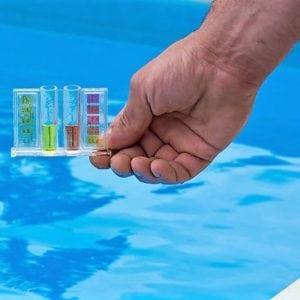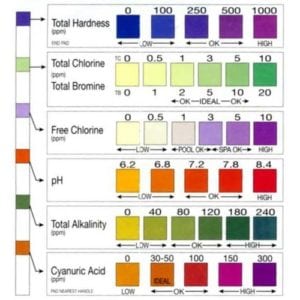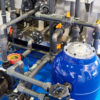O.k., so you have the test kit or strips- now what? You need to know what you are testing the water for and why.
What we are testing the water for- the very basics:
- Total Chlorine
- Free Chlorine
- pH
Let’s stick with the very basics first. Sanitizing the water is usually done with a Chlorinating compound so the kits testing the water looks for the presence of Chlorine, specifically, it’s oxidizing and disinfecting byproduct HOCL. So your test kit or strip should be able to give us a Total and Free Chlorine reading. We want a minimum of 1 ppm on this reading. Maximum reading varies depending upon bather load, temperature, product labels, and presence of chlorine demand at the time of chemical addition.
It is unsafe to swim in water with a Chlorine reading below 1 PPM.
The reason we test for both Total and Free Chlorine is we want to establish if they are the same reading. If they are the same reading then your pool is free from combined chlorine. If the total is higher than the free chlorine reading then the difference in the two indicates the amount of combined chlorine in your pool. That is chlorine that has combined with other chemicals or organic matter in the water rather than destroying them through the oxidation process. This is generally bad and indicates a need to shock your pool to eliminate this combined chlorine.
Please don’t swim in a pool with combined chlorine present.
So once you have determined the chlorine reading we have to check the pH of the pool. Operating ranges for pool pH are 7.2 to 7.8 with 7.4 to 7.6 considered ideal based on three factors.
- Swimmer Comfort
- Sanitizer efficacy
- Pool finish and equipment longevity
In general, the lower the pH the more effective chlorine sanitizers are. So why don’t we
run pH below 7.0 in pools? Because human beings, the ones who are supposed to be enjoying the pool, are pH 7.5 approximately so pool users are the first consideration on the pH recommendations.


So you have a chlorine reading of at least 1 PPM and ZERO combined chlorine and the pH is in the desired range. You’re ready to move on to the next step. Please read your test kit instruction carefully to understand other tests and refer back to my “Getting the pool ready-Pool Test Kit Choice,” if needed.



